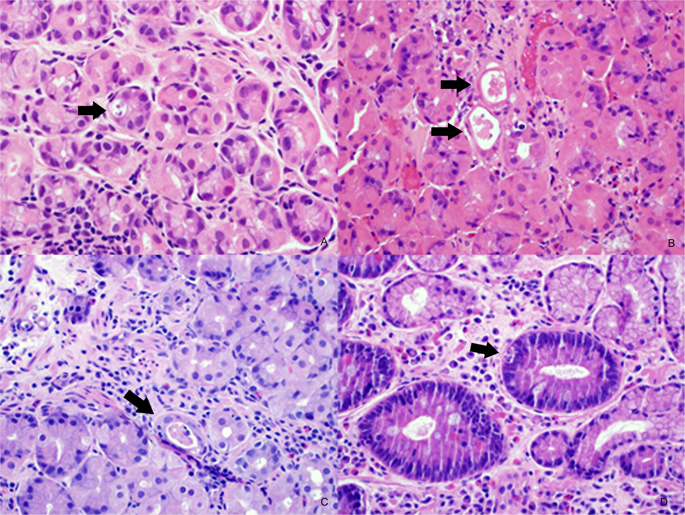当前位置:
X-MOL 学术
›
Modern Pathol.
›
论文详情
Our official English website, www.x-mol.net, welcomes your feedback! (Note: you will need to create a separate account there.)
Evaluation of the lower histologic threshold for gastric graft versus host disease.
Modern Pathology ( IF 7.5 ) Pub Date : 2019-12-19 , DOI: 10.1038/s41379-019-0421-7 Mohamed Mostafa 1 , Christopher P Hartley 1 , Catherine E Hagen 1
Modern Pathology ( IF 7.5 ) Pub Date : 2019-12-19 , DOI: 10.1038/s41379-019-0421-7 Mohamed Mostafa 1 , Christopher P Hartley 1 , Catherine E Hagen 1
Affiliation

|
Data regarding the lower diagnostic threshold for gastric graft-versus-host disease is lacking. The aim of this study was to review a cohort of gastric biopsies taken to evaluate for graft-versus-host disease, and to correlate histologic findings with clinical and endoscopic evidence of graft-versus-host disease as well as biopsy findings from other locations to define a lower diagnostic threshold for gastric graft-versus-host disease. Gastric biopsies were evaluated for the maximum number of apoptotic bodies per 10 contiguous gastric pits, presence of ≥1 apoptotic body per biopsy (NIH criteria), and presence of gastric pit dropout and/or ulceration. To evaluate histologic specificity, sixty gastric biopsies from non-stem cell transplant patients were selected as a control group. Clinical information was collected from chart review. The study group consisted of 65 gastric biopsies from 52 stem cell transplant patients. The mean apoptotic count per 10 contiguous gastric pits for stem cell transplant biopsies was 1.8 (range 0-8) and for control cases 1.0 (range 0-5). Nineteen stem cell transplant biopsies (29%) had ≥1 apoptotic body per biopsy and only a single case had >6 apoptotic bodies per 10 contiguous gastric pits. When the NIH guidelines were combined with presence of at least two apoptotic bodies per 10 contiguous gastric pits, this cutoff point was significantly associated with treatment for graft-versus-host disease (OR = 9.4, 95% CI = 1.7-176.7, p = 0.04) and evidence of extraintestinal graft-versus-host disease (OR = 3.2, 95% CI = 1.1-10.7, p = 0.04). The diagnostic specificity for our proposed cutoff value is 94%. We present criteria for the lower diagnostic threshold of gastric graft-versus-host disease, which uses a lower apoptotic cutoff value than has been utilized in colonic biopsies. Although sensitivity remains a challenge for gastric graft-versus-host disease biopsies, this newly proposed cutoff provides higher specificity than NIH guidelines alone and better correlates with clinical evidence of graft-versus-host disease.
中文翻译:

评估胃移植物抗宿主病的组织学下限。
缺乏关于胃移植物抗宿主病诊断阈值较低的数据。本研究的目的是回顾一组为评估移植物抗宿主病而进行的胃活检,并将组织学发现与移植物抗宿主病的临床和内窥镜证据以及其他部位的活检发现联系起来,定义胃移植物抗宿主病的较低诊断阈值。胃活检评估了每 10 个连续胃小窝的最大凋亡小体数、每次活检存在 ≥ 1 个凋亡小体(NIH 标准)以及胃小窝脱落和/或溃疡的存在。为了评估组织学特异性,从非干细胞移植患者中选择了 60 个胃活检组织作为对照组。从图表审查中收集临床信息。研究组包括来自 52 名干细胞移植患者的 65 份胃活检。干细胞移植活组织检查中每 10 个连续胃凹坑的平均凋亡计数为 1.8(范围 0-8),而对照病例为 1.0(范围 0-5)。19 例干细胞移植活检 (29%) 每次活检有 ≥ 1 个凋亡小体,只有一个病例每 10 个相邻的胃凹坑有 > 6 个凋亡小体。当 NIH 指南与每 10 个连续胃凹坑中至少存在两个凋亡小体相结合时,该截止点与移植物抗宿主病的治疗显着相关(OR = 9.4,95% CI = 1.7-176.7,p = 0.04) 和肠外移植物抗宿主病的证据 (OR = 3.2, 95% CI = 1.1-10.7, p = 0.04)。我们建议的截止值的诊断特异性为 94%。我们提出了胃移植物抗宿主病诊断阈值较低的标准,该标准使用比结肠活检中使用的细胞凋亡截断值更低的截断值。尽管敏感性仍然是胃移植物抗宿主病活检的挑战,但这一新提出的截止值提供了比单独的 NIH 指南更高的特异性,并且与移植物抗宿主病的临床证据更好地相关。
更新日期:2019-12-19
中文翻译:

评估胃移植物抗宿主病的组织学下限。
缺乏关于胃移植物抗宿主病诊断阈值较低的数据。本研究的目的是回顾一组为评估移植物抗宿主病而进行的胃活检,并将组织学发现与移植物抗宿主病的临床和内窥镜证据以及其他部位的活检发现联系起来,定义胃移植物抗宿主病的较低诊断阈值。胃活检评估了每 10 个连续胃小窝的最大凋亡小体数、每次活检存在 ≥ 1 个凋亡小体(NIH 标准)以及胃小窝脱落和/或溃疡的存在。为了评估组织学特异性,从非干细胞移植患者中选择了 60 个胃活检组织作为对照组。从图表审查中收集临床信息。研究组包括来自 52 名干细胞移植患者的 65 份胃活检。干细胞移植活组织检查中每 10 个连续胃凹坑的平均凋亡计数为 1.8(范围 0-8),而对照病例为 1.0(范围 0-5)。19 例干细胞移植活检 (29%) 每次活检有 ≥ 1 个凋亡小体,只有一个病例每 10 个相邻的胃凹坑有 > 6 个凋亡小体。当 NIH 指南与每 10 个连续胃凹坑中至少存在两个凋亡小体相结合时,该截止点与移植物抗宿主病的治疗显着相关(OR = 9.4,95% CI = 1.7-176.7,p = 0.04) 和肠外移植物抗宿主病的证据 (OR = 3.2, 95% CI = 1.1-10.7, p = 0.04)。我们建议的截止值的诊断特异性为 94%。我们提出了胃移植物抗宿主病诊断阈值较低的标准,该标准使用比结肠活检中使用的细胞凋亡截断值更低的截断值。尽管敏感性仍然是胃移植物抗宿主病活检的挑战,但这一新提出的截止值提供了比单独的 NIH 指南更高的特异性,并且与移植物抗宿主病的临床证据更好地相关。


























 京公网安备 11010802027423号
京公网安备 11010802027423号